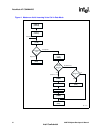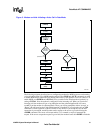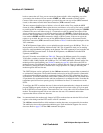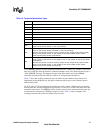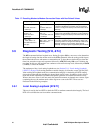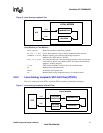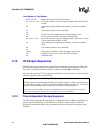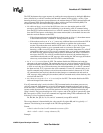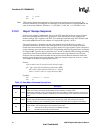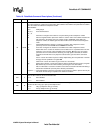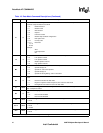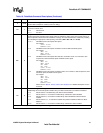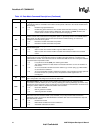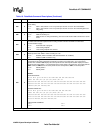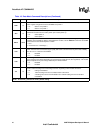
536EX Chipset Developer’s Manual 39
Intel Confidential
Data Mode AT COMMANDS
The DTE implements the escape sequence by sending the escape character (as defined in S2) three
times, followed by a valid AT command, and then the contents of S3 (typically a <CR>). Upon
detecting the three consecutive escape characters, the modem changes to TIES command mode and
starts an internal EPD (Escape Prompt Delay) timer (with the time limit defined by S12). The
modem then looks for one of the following conditions to occur:
• No additional data is received and the EPD timer times out: the modem sends an ‘OK’
message to the DTE and then waits indefinitely for an incoming valid AT command string
from the DTE. Until the modem receives a valid AT command, it monitors any data received
from the DTE and passes on the data to the remote modem (that is, the modem does not echo
back the received character to the DTE).
— If the subsequent character received by the modem is not an ‘A’ or ‘a’, the modem returns
to data mode and sends a ‘CONNECT’ message back to the DTE.
— If the modem receives an ‘A’ or ‘a’, it stores any additional data received from the DTE in
the modem’s internal command buffer and continues to send the data to the remote
modem. The modem then waits until the DTE sends a <CR>, or up to 39 data characters,
before deciding whether to go to command mode or to return to data mode. Upon
detecting a <CR> or receiving the 39 data characters, the modem determines if a valid AT
command has been received. If a non-AT command string or an invalid command string
has been received, then the modem changes back to data mode and sends a ‘CONNECT’
message to the DTE. If a valid AT command has been received, the modem changes to
command mode and sends an ‘OK’ message. After sending the ‘OK’ message, the modem
echoes any received data from the DTE while in command mode.
• An ‘A’ or ‘a’ is received from the DTE. The modem disables the EPD timer and sends the
character to the remote modem. The modem then stores any received data from the DTE into
the modem internal command buffer and sends the data to the remote modem. Upon detecting
a <CR> or receiving up to 39 data characters, the modem determines if a valid AT command
has been received; if so, it processes the valid commands. If a non-AT command string or an
invalid command string has been received, then the modem remains in data mode. If a valid
AT command has been received, then the modem changes to command mode and sends an
‘OK’ message. After sending this, the modem (while in command mode) echoes back any data
received from the DTE.
• Any character except an ‘A’ or ‘a’ is received from the DTE. The modem disables the EPD
timer and changes back to data mode.
If an AT command string is received while in TIES command mode, the modem processes any
valid AT command. Upon detecting an invalid AT command, the modem changes back to data
mode and issues a ‘CONNECT’ message to the DTE. While in TIES command mode, the modem
ignores certain characters that may cause the modem to incorrectly decide that an incoming AT
string is invalid. The ignore characters are <LF>, <space>, and <CR> (<CR> is ignored only when
S3 is not equal to <CR>). Not all AT commands are supported during TIES command mode. The
following is a list of supported commands:
En, Hn, Mn, On, Qn, Sn, Vn, Xn, and ‘&’ commands (except &Tn and &F)
The escape character is determined by the value stored in S-register S2, and it is typically a ‘
+’
character. The following is an example of the TIES Escape Sequence:
Format:
<char1><char2><char3><AT command><contents of S3>
char1 = char2 = char3 = escape character (S2)
Example:




